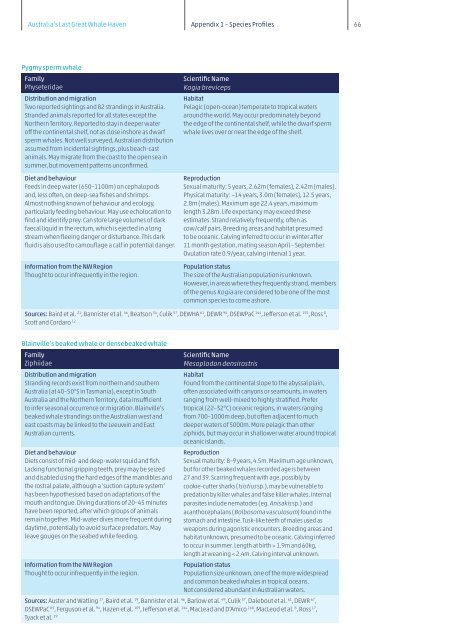Australia's last great whale haven.pdf - Ningaloo Atlas
Australia's last great whale haven.pdf - Ningaloo Atlas
Australia's last great whale haven.pdf - Ningaloo Atlas
- TAGS
- whale
- ningaloo
- atlas
- www.ifaw.org
You also want an ePaper? Increase the reach of your titles
YUMPU automatically turns print PDFs into web optimized ePapers that Google loves.
Australia’s Last Great Whale Haven Appendix 1 – Species Profiles<br />
66<br />
Pygmy sperm <strong>whale</strong><br />
Family<br />
Physeteridae<br />
Distribution and migration<br />
Two reported sightings and 82 strandings in Australia.<br />
Stranded animals reported for all states except the<br />
Northern Territory. Reported to stay in deeper water<br />
off the continental shelf, not as close inshore as dwarf<br />
sperm <strong>whale</strong>s. Not well surveyed, Australian distribution<br />
assumed from incidental sightings, plus beach-cast<br />
animals. May migrate from the coast to the open sea in<br />
summer, but movement patterns unconfirmed.<br />
Diet and behaviour<br />
Feeds in deep water (650–1100m) on cephalopods<br />
and, less often, on deep-sea fishes and shrimps.<br />
Almost nothing known of behaviour and ecology,<br />
particularly feeding behaviour. May use echolocation to<br />
find and identify prey. Can store large volumes of dark<br />
faecal liquid in the rectum, which is ejected in a long<br />
stream when fleeing danger or disturbance. This dark<br />
fluid is also used to camouflage a calf in potential danger.<br />
Information from the NW Region<br />
Thought to occur infrequently in the region.<br />
Scientific Name<br />
Kogia breviceps<br />
Habitat<br />
Pelagic (open-ocean) temperate to tropical waters<br />
around the world. May occur predominately beyond<br />
the edge of the continental shelf, while the dwarf sperm<br />
<strong>whale</strong> lives over or near the edge of the shelf.<br />
Reproduction<br />
Sexual maturity: 5 years, 2.62m (females), 2.42m (males).<br />
Physical maturity: ~14 years, 3.0m (females), 12.5 years,<br />
2.8m (males). Maximum age 22.4 years, maximum<br />
length 3.28m. Life expectancy may exceed these<br />
estimates. Strand relatively frequently, often as<br />
cow/calf pairs. Breeding areas and habitat presumed<br />
to be oceanic. Calving inferred to occur in winter after<br />
11 month gestation, mating season April – September.<br />
Ovulation rate 0.9/year, calving interval 1 year.<br />
Population status<br />
The size of the Australian population is unknown.<br />
However, in areas where they frequently strand, members<br />
of the genus Kogia are considered to be one of the most<br />
common species to come ashore.<br />
Sources: Baird et al. 21 , Bannister et al. 46 , Beatson 54 , Culik 57 , DEWHA 61 , DEWR 94 , DSEWPaC 144 , Jefferson et al. 155 , Ross 8 ,<br />
Scott and Cordaro 12<br />
Blainville’s beaked <strong>whale</strong> or densebeaked <strong>whale</strong><br />
Family<br />
Ziphiidae<br />
Distribution and migration<br />
Stranding records exist from northern and southern<br />
Australia (at 40–50°S in Tasmania), except in South<br />
Australia and the Northern Territory, data insufficient<br />
to infer seasonal occurrence or migration. Blainville’s<br />
beaked <strong>whale</strong> strandings on the Australian west and<br />
east coasts may be linked to the Leeuwin and East<br />
Australian currents.<br />
Diet and behaviour<br />
Diets consist of mid- and deep-water squid and fish.<br />
Lacking functional gripping teeth, prey may be seized<br />
and disabled using the hard edges of the mandibles and<br />
the rostral palate, although a ‘suction capture system’<br />
has been hypothesised based on adaptations of the<br />
mouth and tongue. Diving durations of 20–45 minutes<br />
have been reported, after which groups of animals<br />
remain together. Mid-water dives more frequent during<br />
daytime, potentially to avoid surface predators. May<br />
leave gouges on the seabed while feeding.<br />
Information from the NW Region<br />
Thought to occur infrequently in the region.<br />
Scientific Name<br />
Mesoplodon densirostris<br />
Habitat<br />
Found from the continental slope to the abyssal plain,<br />
often associated with canyons or seamounts, in waters<br />
ranging from well-mixed to highly stratified. Prefer<br />
tropical (22–32°C) oceanic regions, in waters ranging<br />
from 700–1000m deep, but often adjacent to much<br />
deeper waters of 5000m. More pelagic than other<br />
ziphiids, but may occur in shallower water around tropical<br />
oceanic islands.<br />
Reproduction<br />
Sexual maturity: 8–9 years, 4.5m. Maximum age unknown,<br />
but for other beaked <strong>whale</strong>s recorded age is between<br />
27 and 39. Scarring frequent with age, possibly by<br />
cookie-cutter sharks (Isistius sp.), may be vulnerable to<br />
predation by killer <strong>whale</strong>s and false killer <strong>whale</strong>s. Internal<br />
parasites include nematodes (eg. Anisakis sp.) and<br />
acanthocephalans (Bolbosoma vasculosum) found in the<br />
stomach and intestine. Tusk-like teeth of males used as<br />
weapons during agonistic encounters. Breeding areas and<br />
habitat unknown, presumed to be oceanic. Calving inferred<br />
to occur in summer. Length at birth > 1.9m and 60kg,<br />
length at weaning < 2.4m. Calving interval unknown.<br />
Population status<br />
Population size unknown, one of the more widespread<br />
and common beaked <strong>whale</strong>s in tropical oceans.<br />
Not considered abundant in Australian waters.<br />
Sources: Auster and Watling 17 , Baird et al. 19 , Bannister et al. 46 , Barlow et al. 49 , Culik 57 , Dalebout et al. 61 , DEWR 67 ,<br />
DSEWPaC 83 , Ferguson et al. 94 , Hazen et al. 109 , Jefferson et al. 144 , MacLead and D’Amico 168 , MacLeod et al. 8 , Ross 17 ,<br />
Tyack et al. 19

















